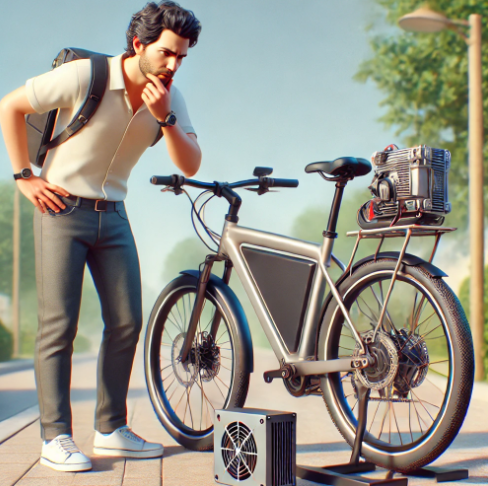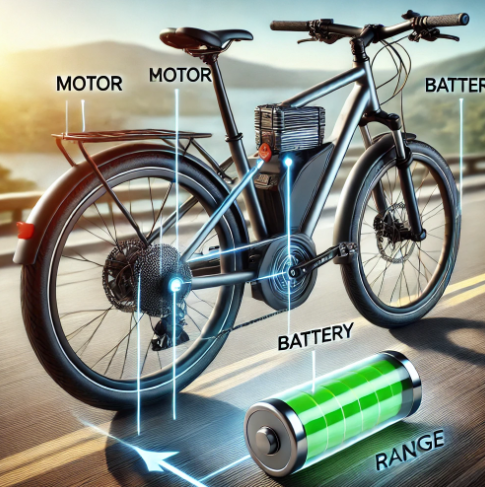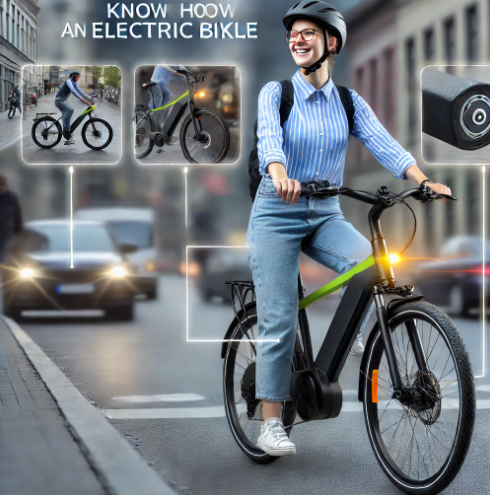How does the electric bike work?
Everything you need to know
Key components to understand how the electric bike works
“How does an electric bike work?
Discover the mechanism behind this innovative means of transport, which combines efficiency and sustainability to make your journeys more agile and eco-friendly.”
Understanding how an electric bike works requires familiarizing yourself with the key components that differentiate it from a conventional bicycle. Electric bicycles, or e-bikes, are designed to provide pedal assistance, allowing riders to travel longer distances, climb hills with ease, and reduce physical effort.
“Have you ever wondered how does an electric bike work? We’ll explain it to you step by step.” Below, we’ll explore the main components that are essential to understanding how does an electric bike work. “From the motor to the battery: How does an electric bike work and what makes it different?”
1. The motor
The motor is the heart of any electric bike. It’s the component that generates the extra power to assist in pedaling. There are different types of motors on electric bikes, but the most common are mid-drive motors and hub motors. Mid-drive motors are placed on the pedal axle, allowing for even weight distribution and greater efficiency on rough terrain. On the other hand, hub motors, either at the front or rear, offer more direct assistance.
Understanding how this motor works is key to choosing an electric bike that fits the user’s needs. In general, the motor is activated when the rider starts pedaling and provides assistance proportional to the effort, reducing physical strain and making the ride more comfortable and faster.
2. The Battery
Another key component to understanding how does an electric bike work is the battery. The batteries power the motor and are responsible for providing the energy that assists the rider. Most electric bikes use lithium-ion batteries, known for their durability and lightness. The battery capacity is measured in watt-hours (Wh), and the higher this capacity, the greater the distance the bike can travel before needing a recharge.
Charging time and range vary depending on the battery capacity and the usage of the bike. Generally, an electric bike can travel between 40 and 120 kilometers on a single charge, depending on factors such as the level of assistance used, the rider’s weight, and the terrain. Understanding these factors is crucial to making the most of the electric bike’s performance.

3. The Pedal-Assist System
The pedal-assist system is the mechanism that connects the motor with the rider’s effort. Through sensors, the bike detects when and how much the rider is pedaling, adjusting the motor assistance accordingly. There are two main types of sensors: the cadence sensor and the torque sensor. The cadence sensor measures the speed at which the rider pedals, while the torque sensor measures the force applied to the pedals.
This system is essential for the bike to work efficiently, as it optimizes motor usage according to the rider’s needs. Thanks to these sensors, the pedaling feels natural, and the transition between electric assistance and physical effort is smooth.
4. The Controller
The controller is the “command unit” that coordinates the various electric components of the bike. It is the brain behind how does an electric bike work, as it regulates the amount of energy sent from the battery to the motor based on the level of assistance selected by the rider. The rider can adjust this assistance from the handlebars, choosing between different modes, from light assistance to maximum power, ideal for steep terrains or long rides.
How does an electric bike work: Motor, battery, and range?
How does an electric bike work and what advantages does it offer over a conventional bike?
An electric bike stands out for its ability to combine the rider’s physical effort with the assistance of an electric motor. This hybrid system offers an easier and more efficient way to move, especially on long or challenging rides. To understand how does an electric bike work, motor, battery, and range are three key components that work together to provide the necessary electric assistance.
The Motor: The Power Behind the Boost
The motor is the heart of an electric bike. It is usually located in the rear wheel hub, the front wheel, or centrally near the bottom bracket. This device converts the battery’s electrical energy into mechanical energy, which in turn propels the bike. Motors can vary in power, with the most common ranging between 250W and 750W. The more powerful the motor, the greater the speed and the easier it is to climb hills without effort. However, there is a speed limit imposed in some countries, typically 25 km/h or 45 km/h, depending on local regulations.
There are two main types of motors in electric bikes: front and rear hub motors, and mid-drive motors. The former are simpler and more affordable, but mid-drive motors tend to be more efficient, offering balanced weight distribution and a more natural pedaling experience.

The Battery: The Power Source
To fully understand how does an electric bike work—motor, battery, and range—the battery plays a crucial role. Electric bikes generally use lithium-ion batteries due to their long lifespan, light weight, and energy storage capacity. The battery is responsible for supplying the electricity the motor needs to operate. The battery’s capacity is measured in watt-hours (Wh), which indicates how much energy it can store and, therefore, how far the bike can travel.
Electric bikes typically have batteries with capacities ranging from 300 Wh to 700 Wh, offering a range between 40 and over 100 kilometers, depending on factors such as the level of assistance, the terrain, and the rider’s weight. The higher the battery capacity, the greater the distance that can be covered without needing a recharge.
Range: How Far You Can Go
The range of an electric bike refers to the distance you can travel on a full battery charge. Many riders wonder how does an electric bike work—motor, battery, and range working together to provide adequate distance. As mentioned earlier, factors such as motor power, assistance level, and terrain affect the range. If you use an electric bike with high assistance on steep hills, the battery will deplete faster than on a flat route with low assistance.
To maximize range, it’s important to use the gears properly and adjust the assistance level according to the terrain. Some electric bikes also feature a regenerative energy system, similar to electric cars, where the bike recharges the battery in small amounts when braking or descending hills.
It’s a process where these three components work together to offer a smoother and more efficient riding experience. The motor provides the boost, the battery supplies the energy, and the range determines how far you can go. These elements not only make electric bikes practical but also a sustainable and accessible transportation option for many people.
Advantages of Knowing How Does an Electric Bike Work for Daily Use
Understanding how does an electric bike work provides several benefits for daily use. First, knowing how the motor, battery, and range interact helps you make informed decisions about your riding habits, whether it’s selecting the right assistance level or maximizing battery life. This can lead to a more efficient and enjoyable ride.
Second, by understanding these components, you can better maintain the bike, ensuring longevity and performance. For instance, knowing how to manage battery charging cycles and care for the motor will reduce wear and tear, saving you money on repairs in the long run.
Additionally, it allows you to optimize your daily commute by selecting the most appropriate routes, adjusting for terrain, and planning for charging needs. This knowledge can make your electric bike a reliable and sustainable option for daily transportation, contributing to a healthier lifestyle and reducing your carbon footprint.
Optimizing Battery Range
Knowing how does an electric bike work also helps you better manage the battery range. Electric bikes usually have different assistance levels, and by understanding how these affect energy consumption, you can adjust the assistance more intelligently to extend the battery’s life. This is especially useful for long trips or when you don’t have frequent access to charging points.
With a good understanding of the battery system, you’ll know how to optimize your rides and anticipate when you’ll need to charge your bike. Additionally, you’ll be able to identify signs of wear or battery malfunction in time, preventing unexpected issues.

Better Adaptation to Different Terrains
Another important aspect is understanding how does an electric bike work on various types of terrain. Electric bikes are designed to adapt to a wide range of surfaces, from paved roads to rural paths. Knowing the dynamics between the motor, battery, and pedal-assist system will help you choose the right mode for each situation.
For example, on rough or uneven terrain, you can increase the assistance level to avoid excessive strain on your legs. Conversely, on flat terrain, you can reduce assistance to conserve battery power. Understanding these mechanisms will make you a more efficient rider, adaptable to any situation.
Safety and Maintenance
Knowing how does an electric bike work also enhances safety. Understanding the braking system, motor response, and how pedal sensors activate assistance will help you react better to unexpected events. Additionally, you’ll be more aware of the bike’s limits, helping to prevent accidents.
Finally, a solid understanding of how an electric bike works also means being familiar with its maintenance needs. Knowing the key components will allow you to identify when they require inspection or replacement, avoiding costly breakdowns and extending your bike’s lifespan.
Maintenance and Care: How Does an Electric Bike Work in the Long Term?
Electric bikes have gained popularity for making daily commutes more accessible, combining traditional pedaling with the boost of an electric motor. However, to enjoy optimal performance for many years, it is crucial to understand how does an electric bike work and how to maintain its key components. Proper maintenance extends the life of the motor, battery, and electronic systems, while also ensuring a safer and more efficient riding experience.
Battery Care: The Heart of the Electric Bike
The most essential component of an electric bike is its battery. Typically, these are lithium-ion batteries, known for their efficiency and durability. To ensure the battery functions correctly over time, it is important to follow some key tips:
- Regular and Proper Charging: The battery should be charged before it is fully depleted, ideally when it still has between 20% and 30% of its charge. This prevents overcharging and improves its lifespan.
- Proper Storage: If the electric bike will not be used for an extended period, it’s important to store the battery in a cool, dry place, charged to at least 50%. This will preserve its charging capacity.
- Connection Maintenance: Periodically check the charging ports to ensure that there is no dust or debris that could interfere with the connection.
A well-maintained battery can last between three and five years, depending on usage and care.

Electric Motor Care: Ensuring Smooth Operation
The motor is another crucial component in the operation of an electric bike. There are two main types of motors: front or rear hub motors and mid-drive motors. Regardless of the type, regular maintenance is vital to ensure the motor operates efficiently for years.
- Cable and Connection Inspection: It is advisable to check the cables that connect the motor to the battery and the controller. Make sure they are not worn or disconnected.
- Motor Cleaning: Although motors are designed to withstand weather conditions, it’s important to keep them clean. Avoid exposing the motor to large amounts of water or mud, as this could affect its performance.
- Lubrication of Moving Parts: Some electric bikes have moving parts connected to the motor that require regular lubrication to prevent premature wear and improve motor performance.
By keeping these aspects in check, the electric motor will continue to provide smooth and reliable assistance throughout the bike’s lifespan.
Brake and Electronic System Care
The braking system on an electric bike is typically more robust than on a traditional bike due to the increased speed that the motor provides. Ensure that you check the brakes regularly, adjusting the pads if necessary, and replacing them when they show signs of wear.
Additionally, the electronic systems, such as the controller and the display panel, require special attention. Keep the screen free from dust and moisture, and check the controls to ensure they respond correctly to speed and power adjustments.
General Inspection and Regular Maintenance
To keep an electric bike running optimally in the long term, regular inspections are essential, whether at home or in a specialized workshop. Check the condition of the tires, as the additional weight from the battery and motor can cause the tires to wear out more quickly. Also, make sure the drivetrain and chain are in good condition and properly lubricated.
Regular maintenance not only extends the life of the bike but also ensures a safer and more enjoyable ride.
For more, visit 1aelectricbikes.com
